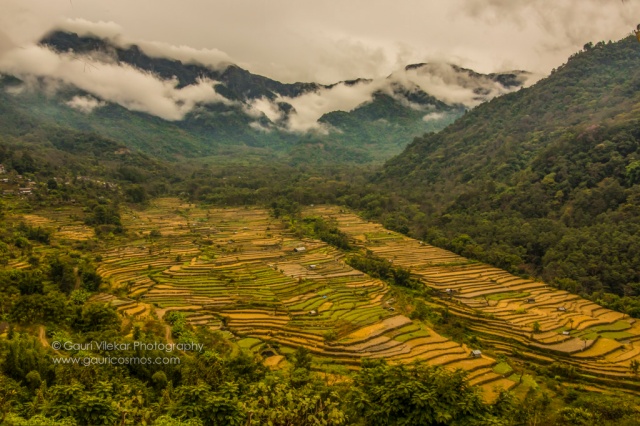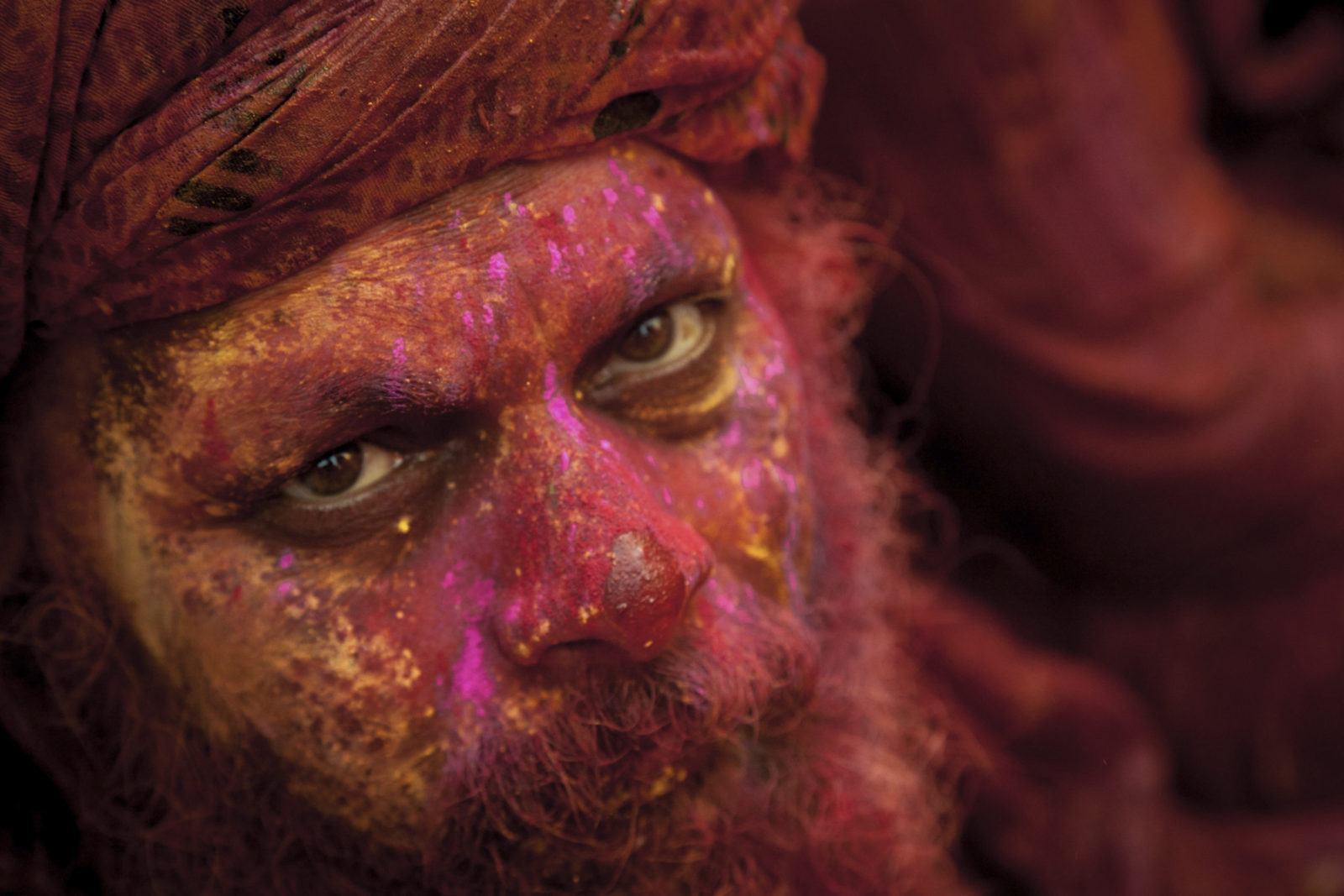
A cheerful and cuddly man, somewhere in his late 60’s, wearing a coat and muffler around his neck, greeted us with a pleasing smile. Uncle Tsilie had been patiently waiting for us at the ticket counter of the Nature Conservation office located at the base of Khonoma. We had traveled for two hours on mucky roads from Kohima in a cramped shared taxi. It was December, but thanx to the unpredictable weather of North-East, it rain out of nowhere! A serpentine road with alternate bends played hide and seek with us until, suddenly, a sleepy Khonoma, nestled in the rolling mountains of Nagaland made its first appearance.

Uncle Tsilie’s home stood on a mountain slope. We climbed up the 150-odd stone steps with our heavy backpacks, panting and sighing until we finally made it to the top. I was amazed to see his grit as he climbed ahead of us, without a gasp! Uncle Tsile’s house was pretty. One section of the house was an elongated block comprising of four rooms in a row with a common corridor. The other section has his room and a kitchen, laced with vibrant wild flowers. Pomegranate and guava trees grew in the porch with other shrubs and grotons along the fence. The home overlooked a stretch of gargantuan mountains with a wide valley in between.

I met Mrs. Tsilie and her adorable kitty that was warming itself next to the burning hearth in the kitchen. One of the rooms was converted into a library. Uncle Tsilie came across as a well-read man and his fetish for books was evident from his compilation. There were books on travel, mythology, history, wiki, astrology, encyclopaedia, science, fiction and more. A few books were gifted to him by the writers and researchers who stayed in his homestay during their work and had pretty words of gratitude for the man. Uncle Tsilie has contributed immensely towards conservation of Khonoma for decades and has been instrumental in placing Khonoma on the map as Asia’s first green village.

With no specific agenda on our mind, we spent the entire evening in the library, sipping on some hot tea while flipping through random books. I stumbled upon a book that spoke about the historical past of Khonoma. It was the land of the brave Angami tribes who fought the British troops with all their might to safeguard their territory, resulting in wars and bloodshed. Many warriors from either sides lost their lives. After about 30 years, a truce happened and eventually Christianity became their main religion. I could now relate to the memorial I had seen at the entrance of the village that morning. British names were engraved on a huge grey stone pillar surrounded by burning candles and fresh flower wreaths.
Dinner prepared by Mrs. Tsilie was simple yet a wholesome gustatory delight. Boiled rice, freshly plucked broccoli and potatoes, dal and crunchy salad were served with a generous garnish of coriander leaves . Post dinner, when we reached our room to retire, our beds were already arranged! I slept under layers of clean and cozy blankets with the blissful sound of the trickling raindrops in my ears.
Gulping our tea in a hurry next morning, we ventured with our local guide into the Tragopan Sanctuary, which is home to the rare and endangered Blyth’s Tragopan. Tragopans are a subset of Pheasants endemic to Himalayas, of which, the Blyth’s Tragopan is found only in Nagaland. These birds are extremely elusive, hence spotting them is mostly a matter of sheer luck. Climbing up a few hundred steps above our home-stay connected us to the main road. Adjacent to the road, on the top of a mountain, our guide pointed out to a naked rock patch that resembled the face of Lord Hanuman and thus, the mountain was considered sacred by the villagers. I could hear hundreds of bird calls, however, could barely spot a handful due to the thick foliage.


The unpaved road slithered amid dense vegetation for almost two kilometres before disappearing into the woods. We trekked on gradual elevation, passing through abundant wild apple trees. Hundreds of small green apples, mostly half-eaten by the Mithuns (wild cows) were scattered all around; Their citric but sweet fragrance engulfed the forest along with the intoxicating scent of wild oranges and lemons. The damp soil was laced with brilliant flowers blooming in varied shapes and sizes. After about two hours into the jungle, we still did not have any luck on sighting the Blyth’s Tragopan. On our way back, we stopped by a virgin brook that flowed serenely through the mossy rocks, looking incredibly mystical in the play of shadows and light. How could I stop myself from tasting its sweet and chilled waters?

The valley that lay between the home-stay and the mountains comprised of massive expanse of infinite step-fields starting at the elevated end and gradually receding all the way down to the base of the village. Each patch of the step-field were fringed with hard soil and stones with narrow canals running along their rims. The air lingered with the fresh aromas of garlic and spinach and fragrant wildflowers. The joy of plucking a luscious organic guava off a tree and biting into its sweet tenderness was indescribable.


An abandoned Naga hut peeped hideously through the tall grass. A lofty mountain stood in the background with giant clouds stuck to its face. A small wooden over-bridge was built to cross over the canals. By the time we reached the base, hundreds of tender, harmless arrows propelled by a local variety of weed held on to my pants so intractably that it became impossible to get rid of them!

We exchanged hugs with Uncle Tsilie and his wife as we bid them goodbye. It was a gloomy Sunday morning. With houses shut and shops closed, Khonoma was silent, except for the sound of the church bells, chirping birds and footsteps of a happy backpacking couple that were climbing down the 150 odd steps one last time.
Snippets
Khonoma is a small picturesque village, 20 kms away from Kohima and is Asia’s first green village. There is absolutely no tourism here, no fancy hotels and no restaurants.
Things to do : Trek to the Tragopan Sanctuary and Explore the brilliant bird life of the region.Wander aimlessly on the terrace fields and relish the organic fruits and vegetables. Relax in the library at Uncle Tsilie’s if you are bookworm. Gain indepth insights to Khonoma- its history is rather interesting.
Where to stay : Uncle Tsilie’s homestay, 8575553862
What to buy : Dried wild-apple bits

